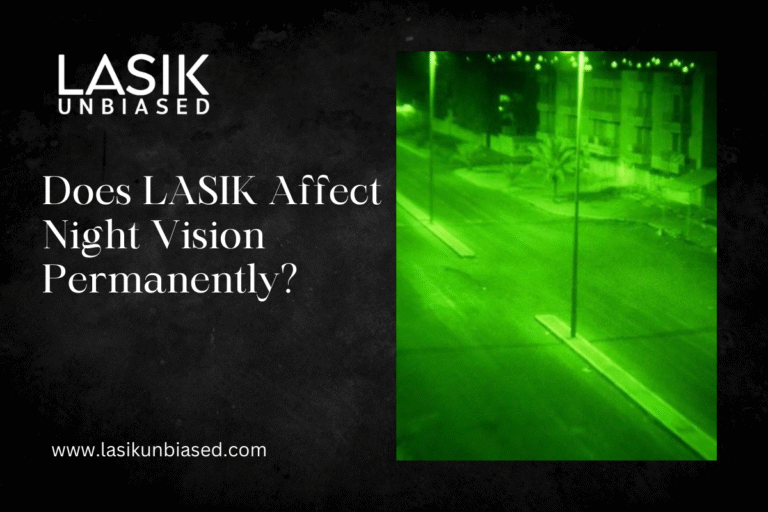No, LASIK does not permanently affect night vision for most patients. While some may initially experience issues like halos or glare, these effects typically subside within weeks or months as the eyes heal.
Night vision concerns are among the most frequently discussed aspects of LASIK surgery. This blog will provide an in-depth exploration of how LASIK impacts night vision, what to expect during recovery, and how to minimise potential side effects.
What Happens to Night Vision After LASIK?
Transient Night Vision Changes Are Common
Night vision disturbances after LASIK are quite common during the recovery phase. These include symptoms such as:
- Halos – Circular light rings around bright sources, especially at night.
- Glare – Increased sensitivity to bright lights in a dark setting.
- Starbursts – Radiating patterns of lights around objects.
- Difficulty Adjusting to Low-light Conditions – Colours and shapes may appear muted in dim environments.
These symptoms are typically more noticeable at night, as the pupil dilates more in the dark, exposing the edges of the LASIK-treated corneal zone.
Why Do These Issues Occur?
These effects result from alterations made to the cornea during surgery. LASIK reshapes the cornea to correct refractive errors, potentially causing irregularities along the edges of the treated area. When light enters the eye, these inconsistencies can scatter light unevenly until the corneal surface smooths out during healing.
Duration of Night Vision Impairments
For most people, night vision disturbances subside within 3-6 months. The cornea’s gradual healing process allows it to stabilise and focus light more accurately. However, temporary changes can feel challenging during the initial healing stage.
Does Everyone Experience Night Vision Issues After LASIK?
Personal Factors That Influence Night Vision Changes
Certain factors increase the likelihood of experiencing temporary night vision issues, such as:
- Pupil Size
Individuals with larger pupils are more likely to notice glare and halos, as more light enters the edges of the treated area.
- Degree of Correction Required
Patients with severe nearsightedness (myopia), farsightedness (hyperopia), or astigmatism may experience greater changes initially, as more significant corneal reshaping is required.
- Pre-existing Vision Conditions
Pre-existing issues like dry eyes can make night vision symptoms more pronounced after LASIK surgery.
Advanced LASIK Technologies to Reduce Risks
Modern LASIK procedures use advanced technologies like wavefront-guided LASIK and custom LASIK. These methods create highly precise corneal maps that reduce the likelihood of night vision disturbances by improving the accuracy of corneal reshaping.
Are Night Vision Changes Ever Permanent?
Rare Cases of Long-lasting Effects
Although rare, some individuals may experience prolonged night vision symptoms that do not fully resolve. These cases often stem from:
- Irregular Corneal Healing
Issues such as uneven surface healing can lead to residual irregularities after surgery.
- Residual Refractive Errors
Even after LASIK, some patients may retain underlying refractive errors (e.g., slight under-correction or over-correction), resulting in minor visual disturbances.
- Underlying Eye Conditions
Conditions unrelated to LASIK (such as cataracts or retinal issues) may worsen night vision and complicate recovery.
It’s critical to note that modern advancements in LASIK have significantly minimised the risk of permanent side effects, making such cases exceedingly rare.
Measures to Alleviate Night Vision Problems
1. Use Prescribed Eye Drops
Dryness is a significant contributor to post-LASIK visual disturbances. Lubricating eye drops help maintain the cornea’s moisture and clarity, reducing glare and halos.
2. Wear Glasses Under Certain Conditions
During the recovery period, specially designed glasses with anti-reflective coatings can reduce glare.
3. Follow Your Surgeon’s Post-op Advice
Surgeons often recommend avoiding driving at night and reducing screen time in the early healing stages, as bright lights could worsen discomfort.
4. Limit Exposure to Bright Lights
Adjust exposure to artificial lights during the first few months to minimise strain on newly-healed eyes.
5. Schedule Follow-up Appointments
Routine check-ups allow your surgeon to monitor healing progress and address any irregularities early.
How Common Are Best Outcomes for LASIK and Night Vision?
Understanding Patient Satisfaction Rates
LASIK surgery has an impressive satisfaction rate, with over 95% of patients reporting improved vision quality long-term. This includes those with previous night vision problems caused by refractive errors.
Role of Personalised LASIK Planning
Customised procedures tailored to each individual’s vision needs ensure a higher chance of optimal results, including clearer night vision.
Advanced LASIK Enhancements
Today’s LASIK technologies eliminate concerns once associated with the procedure. Features like laser-assisted flap creation and pupil tracking improve alignment and focus, leading to better optimisation for nighttime settings.
Who Should Reassess LASIK as an Option?
If You Frequently Drive at Night
Patients who regularly drive at night may worry about experiencing halos or glare. Speak to your surgeon about options like topography-guided LASIK, which corrects minor corneal irregularities, or alternative procedures if LASIK is unsuitable.
If You Already Have Persistent Dry Eyes
LASIK may temporarily exacerbate dryness. Your surgeon may suggest pre-treatment for dry eye symptoms to prepare for better surgery outcomes.
If You’re Considering Alternatives
If LASIK isn’t the best fit for your vision type, alternatives like PRK (Photorefractive Keratectomy) or SMILE (Small Incision Lenticule Extraction) may better suit your needs.
Ensuring the Best Results for Night Vision After LASIK
- Comprehensive Pre-surgical Assessment
A thorough eye examination by a qualified surgeon identifies risk factors influencing post-LASIK vision changes.
- Choosing an Experienced LASIK Provider
Opting for a reputable LASIK centre with access to advanced technologies ensures the best results.
- Understanding the Science of Healing
Knowing that mild vision irregularities are normal during recovery can help alleviate post-operative concerns.
Additional Steps and Final Thoughts
LASIK is a minimally invasive and highly effective procedure with substantial proven benefits, including improved night vision for most patients. If you’re concerned about potential side effects, speak openly with your eye surgeon to fully understand the procedure, expectations, and aftercare.
Clear vision doesn’t have to be limited by darkness. Modern medical advancements have made LASIK safer and more precise than ever, redefining how people with refractive errors see the world.
Take your first step towards a clearer vision. Consult a LASIK expert, learn more about advanced options, and reclaim your independence in all lighting conditions.


